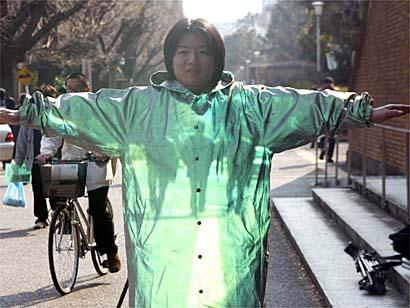Seeing Things
This House Is Wired for the 21st Century...We shall not cease from exploration - T S Eliot, “Little Gidding”
We are having our house remodelled; my sons prepared a walkthrough in 3D Max so we could ensure the changes we had in mind would indeed fit (that project is still ongoing). We did a preliminary test render in wireframe (because it was faster). But I found I liked the look better. I would be perfectly happy living in a house made of plexiglas and wire with no junk or dust in sight anywhere! But that sort of place exists only in MaxWorld and Philip Johnson's head.
Click to Begin
Another Way to See Through Things...Inventor Aiming for Invisible Walls
The inventor of an "invisibility" cloak says his next project will be to help people see through walls. Susumu Tachi, who showed off his cloak at an exhibition in San Francisco earlier this month, now hopes to provide a view of the outside in windowless rooms. "This technology can be used in all kinds of ways, but I wanted to create a vision of invisibility," he told BBC World Service's Outlook programme. "My short-term goal would be, for example, to make a room that has no outside windows appear to have a view to the outside, then the wall would appear to be invisible." Professor Tachi's cloak works by projecting an image onto itself of what is behind the wearer. A computer generates the image that is projected, so the viewer effectively sees "through" the cloak. There are many potential uses of the cloak, ranging from espionage and military purposes to helping pilots see through the floor of the cockpit to the runway below. However there are massive questions of potential misuse too, particularly surrounding the huge crime implications. Source: ananova.com Monday 14 June 2004
If the view outside is less than perfect, maybe it could override what's there with what should be there (the view you deserve)?
Scientific Wizards Find Real Cloak of Invisibilityby James Reynolds A cloaking device that makes objects invisible is being developed by researchers, bringing the magic of Harry Potter into the world of science fact. While Harry uses his cloak of invisibility to move about Hogwarts School unseen, electronic engineers at the University of Pennsylvania are working on a real invisibility shield called a "plasmonic cover." The development, which works by preventing objects from reflecting and scattering light, could have widespread use in the military as it would be more effective than current stealth technology. Although no final product has been made, the engineers claim their proposal "does not obviously violate any of the laws of physics." Other types of invisibility cloaks have been developed before, but these mostly use the "chameleon principle" - colouring objects to match their background, enabling them to blend in and become camouflaged. One such system involved using light detectors and emitters that project a replica of the image appearing behind an object on to its front surface. Similarly, researchers in Tokyo are developing a camouflage fabric that uses a comparable principle where the background is projected on to light-reflecting beads in the material. Such systems are, however, dependent on the viewer from which the object is being concealed being in the right position. A report in the journal Nature reveals that the new system is far more ambitious, being both self-contained and reducing visibility from all angles. In this sense it would be more like the shields used by the Romulans in the Star Trek episode "Balance of Terror" which hid their spaceship at the touch of a button. Dr John Pendry, a physicist at Imperial College London, said: "The concept is an interesting one. It could find uses in stealth technology and camouflage." According to Dr Andrea Alu and Dr Nader Engheta, the engineers behind the project, the key is to reduce light scattering. Objects are visible because light bounces off them; if this can be prevented and if the objects did not reflect any light, they would become invisible. The "plasmonic screen" achieves this by resonating in tune with the illuminating light. Plasmons are created when the electrons on the surface of a metallic material move in rhythm. The developers claim a shell of this material will reduce light-scatter to the extent that an object will become invisible, if the light’s frequency is close to the resonant frequency of these plasmons. In this way, the scattering from the shell effectively cancels out the scattering from the object. Experiments have shown that spherical or cylindrical objects coated with such shields do produce very little light scattering, which renders them nearly invisible. However, the cloak would have to be delicately tuned to suit each object it hides. Also, a specific shield may only work for one wavelength of light, rendering it invisible in, say, red light, but not in multi-wavelength daylight. Another problem which has to be solved is that the effect would only work in daylight when the wavelength of the light being scattered is the same size as the object - meaning only tiny things can so far be hidden. Source: news.scotsman.com Tuesday 1 March 2005
Do I understand this correctly? There will be an empty "hole in the air" - where you can't see what fills it but you can tell something is hiding itself? And it doesn't block bullets? And, oh yes, right now it must be smaller than a wavelength? This technology had a ways to go...
For more animation, video clips, and shockwave games click the "Up" button below to take you to the index page for this Animation section where you will find all sorts of things. |
 Animals
Animals Animation
Animation Art of Playing Cards
Art of Playing Cards Drugs
Drugs Education
Education Environment
Environment Flying
Flying History
History Humour
Humour Immigration
Immigration Info/Tech
Info/Tech Intellectual/Entertaining
Intellectual/Entertaining Lifestyles
Lifestyles Men
Men Money/Politics/Law
Money/Politics/Law New Jersey
New Jersey Odds and Oddities
Odds and Oddities Older & Under
Older & Under Photography
Photography Prisons
Prisons Relationships
Relationships Science
Science Social/Cultural
Social/Cultural Terrorism
Terrorism Wellington
Wellington Working
Working Zero Return Investment
Zero Return Investment
